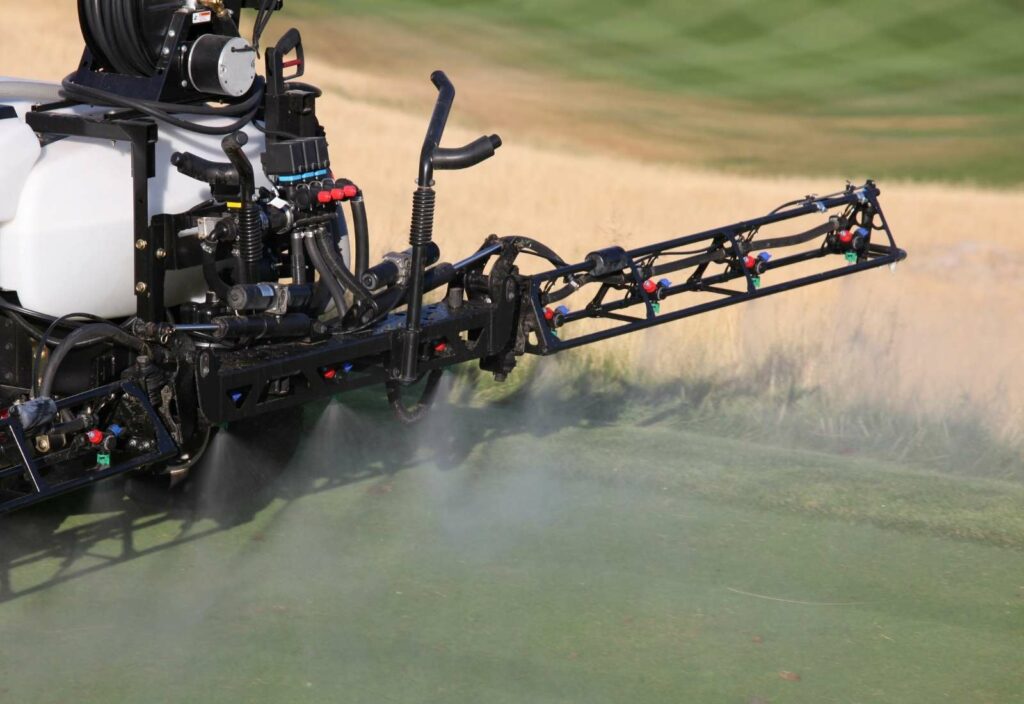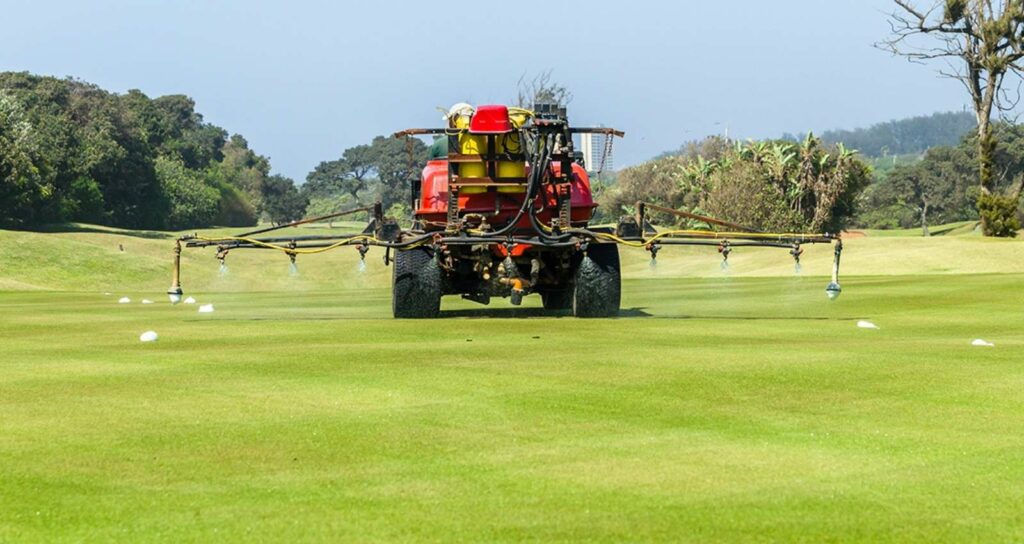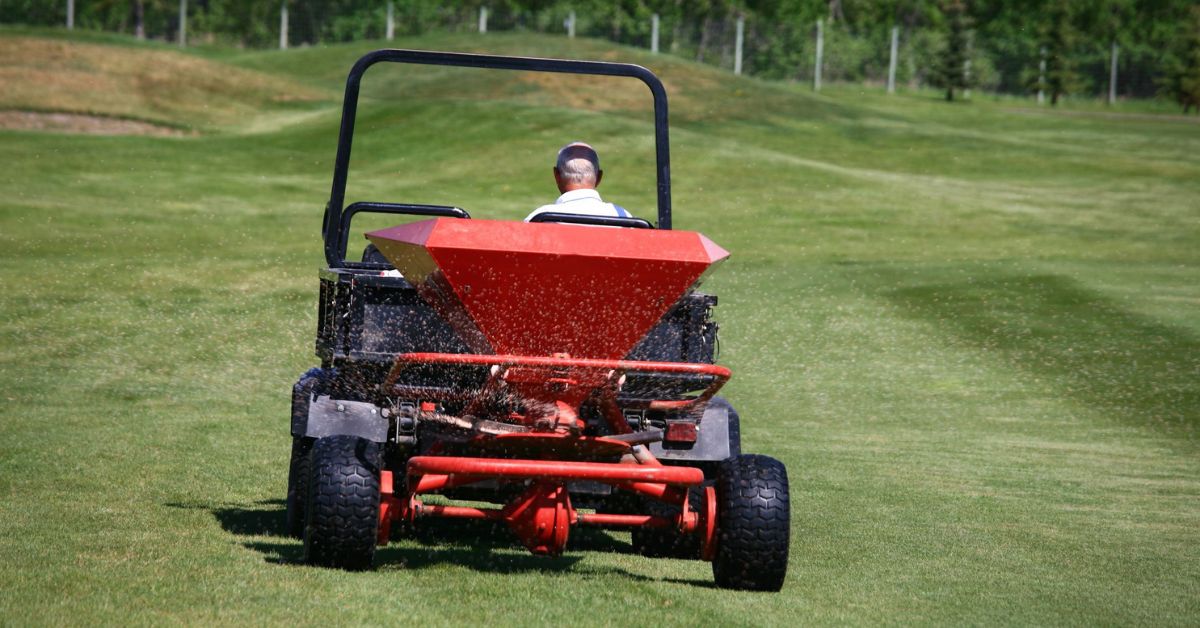Golf courses often feature enviably short and dense grass, with maintenance teams keeping them at a consistently high standard.
To keep the turf in top condition, many courses use the help of fertilizers. These encourage growth and provide essential nutrients to withstand the daily usage of a golf course.
But, how often do golf courses fertilize?
In this article, you’ll learn everything about the fertilization process at a golf course. Including how often golf courses fertilize, the type of fertilizer used, benefits for the turf as well as any potential toxicities.
How Often Do Golf Courses Fertilize?
Greenskeepers usually fertilize the golf course greens once every 2 weeks. Fairways and tee boxes are fertilized twice per year: once in spring, and then again in fall. This keeps the grass healthy throughout the summer, with any areas that lack growth or nutrients receiving additional fertilization in the fall.
Why Do Golf Courses Fertilize?
Golf courses use fertilizer in order to keep the grass in optimal condition.
Fertilizers encourage growth and provide valuable nutrients for the turf. This enables the turf to withstand foot and cart traffic, divots, pitchmarks, and adverse weather conditions.
Particularly, the use of fertilizer promotes the following:
- Root growth
- Shoot growth
- Turf density
At the same time, fertilizers can be used to sustain healthy turf and revive dormant or dying grass. In addition to the fertilizer spray, insecticides can be applied to prevent further damage to the turf.

What Type of Fertilizer Do Golf Courses Use?
Many golf courses use fertilizers with a blend of three elements essential for growth:
- Nitrogen – for plant growth and color
- Phosphorous – for root development
- Potassium – for overall plant strength
Most fertilizer blends combine these three elements in a granular form and any additional micronutrients that the grass might need for growth.
Adam Champion, superintendent at Bearspaw Golf Club, Canada, discusses these fertilizer types in more detail in the video below:
Do Golf Courses Use Liquid Fertilizer?
While slow-release fertilizer blends are used in a granular form twice per year, many courses will also use liquid fertilizer for more immediate results.
Liquid fertilizer is used mainly on greens, but also on fairways in areas that require a more instant response. For example, if a clearly visible patch on the fairway becomes discolored, fertilizer can help match it to the surrounding healthy turf.
What Is the Best Fertilizer for Golf Greens?
Greens are often fertilized every 2 weeks with liquid fertilizer. This provides a quick release of fertilizer to keep them in optimal conditions throughout the season.
The fertilizer can be either hand sprayed, or applied with ride-on machinery. Often, this process can be synced with the green aeration process to minimize disruption to the course.
Do Golf Courses Use Milorganite?
Milorganite is a slow-release fertilizer product composed of 85% organic matter, made by heat-drying wastewater.
Some golf courses use Milorganite fertilizers, as they provide sufficient nutrients without the risk of “burning” the grass. By definition, fertilizer burn happens when high concentrations of fertilizer draw excess moisture from the roots, causing the grass to yellow or die.
Furthermore, Milorganite is appealing as it is an organic fertilizer, without any chemical additives.

Is Golf Course Fertilizer Toxic?
In 1995, the Attorney General of New York conducted the Toxic Fairways study. At the time, it found that golf course superintendents are subject to higher mortality rates from specific cancers. In addition, it highlighted concerns that pesticide drift – the process of particles becoming airborne and landing on neighboring sites – could affect nearby residents.
However, fertilizers and pesticides are safe – if applied correctly.
It’s important that maintenance teams are well-prepped with information about fertilizers before using them. For example, misuse can increase the chance of pollution through run-off, so tarmac cart paths should be avoided. Also, courses should close chemically treated areas of the course for a period of time to prevent public contact.
As mentioned previously in the article, Milorganite is an example of organic fertilizer. Today, many courses avoid overusing of artificial chemicals, instead opting for organic alternatives.
In any case, fertilizers are a valuable asset when used properly and can allow for year-round greenery and premium golf course conditions.
How Much Fertilizer Do Golf Courses Use?
The fertilizer rate of application depends on a number of variables:
- The type of fertilizer used
- The amount of traffic
- The time of year
- The nature of the soil
- The amount of sunlight
Many of these factors are dictated by the course’s location. In areas with limited rain or sunlight, fertilizers will be used more frequently to improve turf growth rates.
Putting greens receive the highest level of attention when it comes to fertilizers. So, courses with bigger greens will therefore use more fertilizer to achieve the desired turf quality.
Fundamentally, the total amount of fertilizer used depends largely on the total size of the course.

How Do Golf Courses Prevent Weeds?
While fertilizers encourage healthy turf growth, herbicides are used to prevent weeds.
Many golf courses engage in a regular schedule of applying pre-emergent herbicides, along with the application of fertilizer. This helps to prevent weeds from appearing in the first place, which is less damaging and time-consuming than weed removal.
However, weed prevention doesn’t work 100% of the time. In cases where weeds do appear, weed-killing agents kill and inhibit the growth of unwanted weeds.
Mowing frequency and aeration also helps to prevent weeds on the golf course. This increases turf density, which makes it difficult for weeds to penetrate the turf.
How Do Golf Courses Keep Grass So Short?
While golf courses often use fertilizers to encourage healthy turf growth, there is an equally important requirement to keep the length of the grass in order.
For the putting greens, specialized types of reel mowers are used to cut the turf to a height of just one-eighth of an inch. This creates a scissor-like action, which clips the blades of grass at the crossing of two cutting edges.
However, for the fairways, rough, and tee boxes, ride-on mowers are used for speed and efficiency.
Golf Course Grass Height
While a typical home lawn is mowed to a height of 2 to 3 inches, the average height of grass on the golf course is kept much lower for optimal play.
In the spring and summer months, golf course operators choose to cut the grass to its lowest level to improve aesthetics while the grass is at its optimal health:
| Golf Course Grass Type | Grass Height in Spring/Summer |
| Greens | Up to 0.125 inches (3 mm) |
| Fairways | 0.35 to 0.5 inches (9-13 mm) |
| Rough | 1.0 to 1.25 inches (25-32 mm) |
In fall and winter, mowing heights are raised slightly as the soil temperatures decrease and the turf thins and becomes dormant:
| Golf Course Grass Type | Grass Height in Fall/Winter |
| Greens | Up to 0.125 inches (3 mm) |
| Fairways | Up to 0.7 inches (18 mm) |
| Rough | Up to 2.0 inches (51 mm) |
Undoubtedly, mowing to a lower height provides playability benefits for golf courses. Increased roll-out helps to provide a more premium feel.
On the other hand, the benefits should be balanced with environmental stresses. Repeatedly cutting the turf too short can impact the long-term health of the turf.

Conclusion
In summary, there are two ways to apply fertilizer on a golf course: granular or liquid.
Greens are fertilized once every 2 weeks using liquid fertilizer. However, the rest of the course is fertilized with granular fertilizer twice a year: once in spring and once in fall.
Also, fertilizers can be applied alongside pesticides and herbicides to prevent insects and weeds from damaging turf health.
Hopefully, this article has taught you everything you need to know about the use of fertilizers on the golf course! It’s certainly easy to take for granted the level of work put into creating these golfing havens.


